Lisa Dawn's Blog: The Princess Blog, page 60
February 2, 2020
Review: The Mermaid's Madness
After I reviewed The Stepsister Scheme by Jim C. Hines, I didn't think I was interested in reading more until I learned that the next book in the series was based on my favorite fairy tale, "The Little Mermaid." Though I reviewed a lot of "Little Mermaid" adaptations lately, I figured one more couldn't hurt. Or could it? I can say with some certainty that fans of the Disney movie would not enjoy this book.
The Mermaid's Madness
is much darker than the Hans Christian Andersen version of the story, which is really saying something. It unapologetically dashed many of my fairy tale princess hopes and dreams, yet the book was a daring undertaking that focused on an aspect of "The Little Mermaid that often gets left out in other adaptations. This is a version in which our protagonist actually goes through with the proposition to kill her beloved prince in order to save herself.
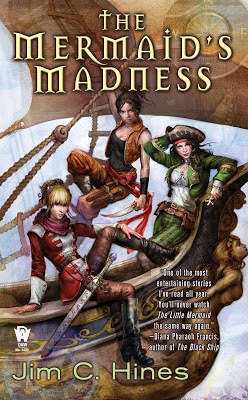
Since The Stepsister Scheme centered around the adventures of Snow White, Cinderella, and Sleeping Beauty, I hoped that The Mermaid's Madness would take us on an adventure with a new mermaid protagonist following the trend of other fairy tale series that switch protagonists in each subsequent book. Instead, it was about the same badass threesome attempting to catch the mermaid queen Lirea after she mortally injured their leader, Queen Beatrice. It was difficult for me to perceive the little mermaid character as a villain after being so inspired by how passionately she loved and sacrificed for so many years. In the end, it turned out that the book was counting on exactly that and revealed an even darker twist to Lirea's madness. The saving grace for me was Lannadae, Lirea's naive younger sister who in many ways acted more like the little mermaid character we are familiar with than Lirea. Lannadae was a wide-eyed young mermaid who loved fairy tales and kept talking about how excited she was to team up with the famous Cinderella, Snow White, and Sleeping Beauty. It's a shame that her innocence was tainted by her tragic experiences with her dysfunctional family.
One of my favorite things about mermaid stories is the discovery of a unique underwater world that exists entirely within the author's imagination. This book did very little to feed my mermaid fantasies. A large portion of it took place on a ship where three protagonists traveled with Lannadae and her grandmother Morveren. It wasn't always clear whether the two mermaids were actually on the ship and somehow submerged in water or swimming beside the ship. There were a few scenes where the main trio transformed into mermaids to run an espionage mission to gather information about Lirea's whereabouts. These scenes focused more on their gruesome transformation that involved cutting their legs open and using magic to sew them together than on the experience of being a mermaid and exploring the underwater kingdom. There was also some unnecessary nudity in a later scene due to the nature of the transformation process, which was even more awkward due to the fact that one of the princesses was secretly gay.
All of the notable elements of The Stepsister Scheme that made it clear it was written by a man stood out even more apparent in The Mermaid's Madness. Most princess books I read are written by women who understand that we care more about love, kindness, and sentiment in our stories than violence or sexuality. The concept of a sarcastic "Black Widow" who could kill you in the blink of an eye is more of a male fantasy. I enjoyed The Stepsister Scheme for its novelty, but by the time I got to The Mermaid's Madness, I was already tired of the unrealistic lack of feminity that all the princesses conveyed with the exception of Lannadae. They were basically men with boobs, seeking to avenge Queen Beatrice by any means possible. The story became more interesting when the big twist was revealed at the end, but it also made it that much more heartbreaking.
The Mermaid's Madness offers a unique look at the story of "The Little Mermaid" from the perspective of someone who doesn't like traditional fairy tales. Fans of Vertigo's Fables comics would enjoy it far more than fans of the Disney movie. The great thing about fairy tales is that they are so well-known in the public domain that you can find retellings of them for any audience. I am probably not within the target audience for this series, but there are those who love the exaggerated darker-than-life Sin City style worlds who would take this version of "The Little Mermaid" as gospel. As for me, I think I'm done with Jim C. Hines' princess books for now.

Since The Stepsister Scheme centered around the adventures of Snow White, Cinderella, and Sleeping Beauty, I hoped that The Mermaid's Madness would take us on an adventure with a new mermaid protagonist following the trend of other fairy tale series that switch protagonists in each subsequent book. Instead, it was about the same badass threesome attempting to catch the mermaid queen Lirea after she mortally injured their leader, Queen Beatrice. It was difficult for me to perceive the little mermaid character as a villain after being so inspired by how passionately she loved and sacrificed for so many years. In the end, it turned out that the book was counting on exactly that and revealed an even darker twist to Lirea's madness. The saving grace for me was Lannadae, Lirea's naive younger sister who in many ways acted more like the little mermaid character we are familiar with than Lirea. Lannadae was a wide-eyed young mermaid who loved fairy tales and kept talking about how excited she was to team up with the famous Cinderella, Snow White, and Sleeping Beauty. It's a shame that her innocence was tainted by her tragic experiences with her dysfunctional family.
One of my favorite things about mermaid stories is the discovery of a unique underwater world that exists entirely within the author's imagination. This book did very little to feed my mermaid fantasies. A large portion of it took place on a ship where three protagonists traveled with Lannadae and her grandmother Morveren. It wasn't always clear whether the two mermaids were actually on the ship and somehow submerged in water or swimming beside the ship. There were a few scenes where the main trio transformed into mermaids to run an espionage mission to gather information about Lirea's whereabouts. These scenes focused more on their gruesome transformation that involved cutting their legs open and using magic to sew them together than on the experience of being a mermaid and exploring the underwater kingdom. There was also some unnecessary nudity in a later scene due to the nature of the transformation process, which was even more awkward due to the fact that one of the princesses was secretly gay.
All of the notable elements of The Stepsister Scheme that made it clear it was written by a man stood out even more apparent in The Mermaid's Madness. Most princess books I read are written by women who understand that we care more about love, kindness, and sentiment in our stories than violence or sexuality. The concept of a sarcastic "Black Widow" who could kill you in the blink of an eye is more of a male fantasy. I enjoyed The Stepsister Scheme for its novelty, but by the time I got to The Mermaid's Madness, I was already tired of the unrealistic lack of feminity that all the princesses conveyed with the exception of Lannadae. They were basically men with boobs, seeking to avenge Queen Beatrice by any means possible. The story became more interesting when the big twist was revealed at the end, but it also made it that much more heartbreaking.
The Mermaid's Madness offers a unique look at the story of "The Little Mermaid" from the perspective of someone who doesn't like traditional fairy tales. Fans of Vertigo's Fables comics would enjoy it far more than fans of the Disney movie. The great thing about fairy tales is that they are so well-known in the public domain that you can find retellings of them for any audience. I am probably not within the target audience for this series, but there are those who love the exaggerated darker-than-life Sin City style worlds who would take this version of "The Little Mermaid" as gospel. As for me, I think I'm done with Jim C. Hines' princess books for now.
Published on February 02, 2020 12:30
January 26, 2020
Review: Tangled - Cassandra's Revenge
Today marks the last multi-part special on Rapunzel's Tangled Adventure before the series finale on March 1st. I had high hopes that
Cassandra's Revenge
would resolve Cassandra's heartbreaking betrayal arc once and for all, but it looks like that is being saved for the finale. Though there were some revelations in this special about Rapunzel and Cassandra's powers, they weren't quite as big as I was hoping. The special brought back Varian for a gorgeous new Alan Menken duet with Cassandra. It also progressed the sinister plans of the mysterious blue girl, who is the true antagonist likely has some sort of connection to Zhan Tiri, the show's final boss. It was an enjoyable special in terms of art and music, but I felt let down by the fact that they are saving all the big resolutions for the finale. Cassandra is beginning to feel like a broken record, saying the same things over again until the plot allows her story to progress.
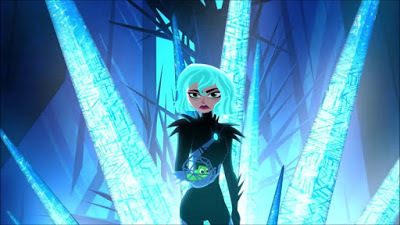
The special kicks off with a new Rapunzel song called "The Girl Who Has Everything," in which Rapunzel channels her inner artist and paints a lovely collage of all the characters and adventures she has encountered over the course of the series. Even though she is a modern princess in some ways, Rapunzel is also very much a classic Disney Princess who knows how to appreciate her blessings and sing about the benefits of staying positive. The opening scene treated us to one of two new Alan Menkens songs in this special. My favorite thing about it was the visuals. Rapunzel's paintings are inspired by the work of Claire Keane, the daughter of Glen Keane, who is responsible for the designs of many classic Disney characters. I love the whimsical flowing strokes of the drawings in Rapunzel's journal that we see during the opening of the show. The paintings she created during this song were so nostalgic and dreamlike that I can't wait to watch it again and try to identify all the little easter eggs and references to previous episodes.
Of course, things can't be all sunshine and rainbows for our golden-haired heroine. We are soon reminded of her woes when Cassandra pulls a Maleficent and crashes Eugene's surprise birthday party on account of not receiving an invitation. Rapunzel tries to reason with her yet again, but it is all in vain when Cass kidnaps Varian along with the famous incantation scroll that was introduced in the second season. Varian discovers two more incantations hidden in the scroll--one for Rapunzel to fight Cassandra's moonstone powers, and one for Cassandra to fight Rapunzel's sun drop powers. Since the original healing incantation is one of the most haunting tracks on the original Tangled soundtrack, and the hurt incantation came with an eerily memorable performance in the season 2 special Rapunzel and the Great Tree, I was hoping for more ethereal chanting. Here, both incantations were spoken. Though they created some powerful explosions and glowing effects, it felt like more of a rehash of the same things we've already seen them do with their powers, especially after the epic season 2 finale. The incantations feel a lot less magical without the music to accompany them.
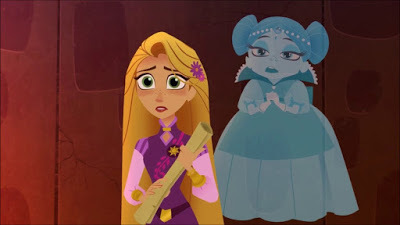
Cassandra's Revenge showed some more of the mysterious blue girl, but I feel like I know even less about her identity now than I did before. It proved what we knew all along--that she was manipulating Cassandra for her own personal gain. That's why I was hoping we would see Cass switch back to Rapunzel's side after she learned she was being used. Unfortunately, the blue girl's reveal came within the final few seconds of the special and left no time for any sort of reaction on Cassandra's part. When we first encountered her, it wasn't clear whether she was evil or a neutral oracle of Cassandra's past. Once the third season began, however, it became obvious that she is the true antagonist of the show. We all know that Rapunzel's ultimate foe will be Zhan Tiri, but not what Zhan Tiri looks like. I think it's possible that the blue girl is Zhan Tiri, one of Zhan Tiri's followers, or even a younger version of Mother Gothel, but I have heard valid arguments to the contrary. There was so much I was hoping this special would reveal that it didn't. I guess I'll just have to be patient like everyone else and wait another month.
Overall, Cassandra's Revenge had some great songs and lovely art, but I was hoping for a little more in terms of story. All it accomplished was advancing the blue girl's wicked plans in anticipation of the final battle. Cassandra continues to hold a grudge against Rapunzel in spite of the fact that she is clearly being manipulated. There were some cute moments between Rapunzel and Eugene, but they were short-lived thanks to the larger crisis at hand. It looks like everything I really wanted out of this special is going to happen in the series finale, Plus Est en Vous, on March 1st. There are still four more episodes before that, so maybe we'll get some more insight into Zhan Tiri and the blue girl's true identity sooner rather than later. One can only hope.

The special kicks off with a new Rapunzel song called "The Girl Who Has Everything," in which Rapunzel channels her inner artist and paints a lovely collage of all the characters and adventures she has encountered over the course of the series. Even though she is a modern princess in some ways, Rapunzel is also very much a classic Disney Princess who knows how to appreciate her blessings and sing about the benefits of staying positive. The opening scene treated us to one of two new Alan Menkens songs in this special. My favorite thing about it was the visuals. Rapunzel's paintings are inspired by the work of Claire Keane, the daughter of Glen Keane, who is responsible for the designs of many classic Disney characters. I love the whimsical flowing strokes of the drawings in Rapunzel's journal that we see during the opening of the show. The paintings she created during this song were so nostalgic and dreamlike that I can't wait to watch it again and try to identify all the little easter eggs and references to previous episodes.
Of course, things can't be all sunshine and rainbows for our golden-haired heroine. We are soon reminded of her woes when Cassandra pulls a Maleficent and crashes Eugene's surprise birthday party on account of not receiving an invitation. Rapunzel tries to reason with her yet again, but it is all in vain when Cass kidnaps Varian along with the famous incantation scroll that was introduced in the second season. Varian discovers two more incantations hidden in the scroll--one for Rapunzel to fight Cassandra's moonstone powers, and one for Cassandra to fight Rapunzel's sun drop powers. Since the original healing incantation is one of the most haunting tracks on the original Tangled soundtrack, and the hurt incantation came with an eerily memorable performance in the season 2 special Rapunzel and the Great Tree, I was hoping for more ethereal chanting. Here, both incantations were spoken. Though they created some powerful explosions and glowing effects, it felt like more of a rehash of the same things we've already seen them do with their powers, especially after the epic season 2 finale. The incantations feel a lot less magical without the music to accompany them.

Cassandra's Revenge showed some more of the mysterious blue girl, but I feel like I know even less about her identity now than I did before. It proved what we knew all along--that she was manipulating Cassandra for her own personal gain. That's why I was hoping we would see Cass switch back to Rapunzel's side after she learned she was being used. Unfortunately, the blue girl's reveal came within the final few seconds of the special and left no time for any sort of reaction on Cassandra's part. When we first encountered her, it wasn't clear whether she was evil or a neutral oracle of Cassandra's past. Once the third season began, however, it became obvious that she is the true antagonist of the show. We all know that Rapunzel's ultimate foe will be Zhan Tiri, but not what Zhan Tiri looks like. I think it's possible that the blue girl is Zhan Tiri, one of Zhan Tiri's followers, or even a younger version of Mother Gothel, but I have heard valid arguments to the contrary. There was so much I was hoping this special would reveal that it didn't. I guess I'll just have to be patient like everyone else and wait another month.
Overall, Cassandra's Revenge had some great songs and lovely art, but I was hoping for a little more in terms of story. All it accomplished was advancing the blue girl's wicked plans in anticipation of the final battle. Cassandra continues to hold a grudge against Rapunzel in spite of the fact that she is clearly being manipulated. There were some cute moments between Rapunzel and Eugene, but they were short-lived thanks to the larger crisis at hand. It looks like everything I really wanted out of this special is going to happen in the series finale, Plus Est en Vous, on March 1st. There are still four more episodes before that, so maybe we'll get some more insight into Zhan Tiri and the blue girl's true identity sooner rather than later. One can only hope.
Published on January 26, 2020 12:40
January 24, 2020
Review: Kingdom Hearts III Re Mind
It's been almost a year since Kingdom Hearts III made its long overdue debut. Amidst the disappointment that fans had with the highly anticipated game, the most popular question of all was "What about Kairi?" The new Kingdom Hearts III: Re Mind DLC, which came out yesterday, attempts to answer this question. Kairi is essentially the princess of the Kingdom Hearts universe, but is never treated as such. She is constantly placed on the sidelines, even after she receives her own keyblade to fight with at the end of Kingdom Hearts II. The Re Mind DLC addresses this issue immediately. When you start up the game after installing the DLC, a lovely new illustration of Kairi slowly fades into existence next to Sora's on the menu screen as a gentle reminder that she has been patiently waiting for her turn to be included in the story.
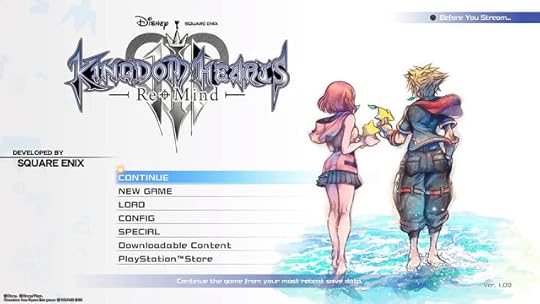
For half the price of the game, I can understand why some people would consider Re Mind to be a disappointment. There are some new scenes and gameplay, but the main part of the story can be completed within three to four hours. For all intents and purposes, it should have been included in the original Kingdom Hearts III after we see Kairi get obliterated by Xehanort and show up again during the ending with no explanation. As much as I enjoyed the bonus quests in the beautiful world of Scala ad Caelum to restore Kairi's heart, I couldn't help but feel that the first two hours of the DLC were wasted by rehashing battles and cutscenes that I had already played through in the original game. In order to restore Kairi's heart, Sora must travel back in time and collect fragments from the people who were closest to her. That means repeating most of the boss fights at the Keyblade Graveyard between the seven Guardians of Light and the New Organization XIII and watching their cutscenes over again. The only difference is that now it gives you the option to fight as Riku, Aqua, and Roxas instead of Sora.
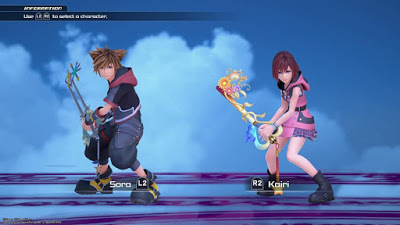
After the clip show, things finally start to get interesting. Sora finds himself in Scala ad Caelum and finally gets the opportunity to explore this surreal environment. There are a few puzzles to pass in order to restore Kairi's heart, but for the most part, they're pretty self-explanatory. The reward for completing all these missions is the ability to fight the final boss as Kairi alongside Sora. Though this is the only part of the DLC where you can play as Kairi, it was fun to hear the harp-like sounds of her keyblade and see some of her special attacks. I may have missed something because I wasn't able to unlock the attack from the trailer where she flies over the enemy and throws her keyblade into a magic circle. The special attack I unlocked for her was called Seven Wishes, a tasteful reference to the seven Princesses of Heart, seven Guardians of Light, and seven shards of Kairi's heart that Sora collected. The attack itself is fairly generic. She flies at the enemy really fast and strikes seven times. The combined special attack that can be unlocked as either Sora or Kairi was the one that was truly special. "One Heart" is a beautiful ability that allows Sora and Kairi to hold hands and grow a pair of sparkly angel wings like Rinoa Heartilly from Final Fantasy VIII in a visual feast of love and magic.
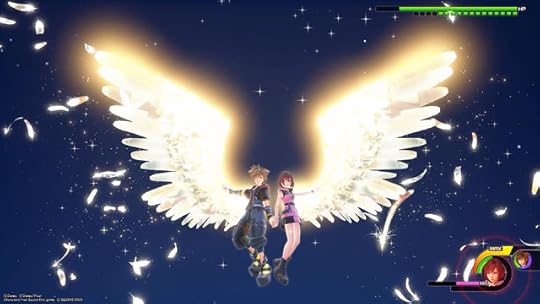
The ending of the Re Mind episode is mostly a rehash of the game's original ending, which made me feel like my time was being wasted yet again with footage I had already seen. There were a few new nuggets, but I wish they had left out the repeat footage entirely. The Re Mind episode gives context to why Kairi appears on Destiny Islands during the ending of Kingdom Hearts III, but the fact remains that Sora channeled his inner "Little Mermaid" and needed to sacrific himself in order to bring her back. That's where Limit Cut, the second episode of the DLC, comes into play. Limit Cut introduces the return of the Final Fantasy characters that were teased in the trailer. Sadly, we don't get to see much more of them than the footage that was already out. In Limit Cut, Cloud, Aerith, Yuffie, and Cid show Riku the data that they collected about Sora in their computer, where the majority of gameplay in this episode takes place. If you've ever played the Final Mix version of Kingdom Hearts II, you are probably familiar with the Data Organization battles. Limit Cut is more of the same. You play as the data version of Sora and must defeat thirteen nigh impossible versions of the New Organization XIII in order to release the data in Cid's computer.
One of the most common complaints about Kingdom Hearts III was that it was way too easy. As much as I agree with that, I don't the best solution was to lock Sora in a room surrounded by thirteen super bosses that were so difficult that my husband threw his controller across the room. Yet, this is the only way to watch the final movie on the DLC. The 100 hours I spent maxing our Sora's level and equipment in Kingdom Hearts III meant absolutely nothing when it came to the Limit Cut battles. I had no advantage of the enemies, even with the Ultima keyblade. Is it so hard to ask for a middle ground? While I could have spent the next few months losing the same battles over and over again, I decided to watch the final movie(s) on YouTube, which made the Limit Cut portion feel of the DLC like a complete waste of money. I'm not sure who they intended this section for, but the only people it benefits are hardcore gamers who want bragging rights after breezing through the rest of the game.
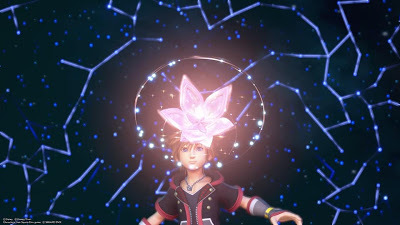
In my opinion, most casual fans will consider the Kingdom Hearts Re Mind DLC a waste of time and money. As a princess fan, I found it to be worth it because it resolved Kairi's story from the end of Kingdom Hearts III, one that was desperately in need of a resolution. There were some touching romantic moments and beautiful new imagery of Sora and Kairi together in battle. However, it was frustrating to go through so much of what I had already seen and played in Kingdom Hearts III just to get to the new quest in Scala ad Caelum. The Limit Cut episode was complete bogus, and I wish there was an easier way to unlock the final scene legitimately. There is no real benefit to maxing out Sora's stats because everything is way too easy until it isn't, which makes the extra work becomes meaningless. Still, the mini-quests to find Kairi's heart were pretty fun and add an extra layer of satisfaction to her cameo during the game's ending. Overall, the DLC just doesn't have much to offer people who don't care about Kairi or aren't monster gamers that can take on any challenge.

For half the price of the game, I can understand why some people would consider Re Mind to be a disappointment. There are some new scenes and gameplay, but the main part of the story can be completed within three to four hours. For all intents and purposes, it should have been included in the original Kingdom Hearts III after we see Kairi get obliterated by Xehanort and show up again during the ending with no explanation. As much as I enjoyed the bonus quests in the beautiful world of Scala ad Caelum to restore Kairi's heart, I couldn't help but feel that the first two hours of the DLC were wasted by rehashing battles and cutscenes that I had already played through in the original game. In order to restore Kairi's heart, Sora must travel back in time and collect fragments from the people who were closest to her. That means repeating most of the boss fights at the Keyblade Graveyard between the seven Guardians of Light and the New Organization XIII and watching their cutscenes over again. The only difference is that now it gives you the option to fight as Riku, Aqua, and Roxas instead of Sora.

After the clip show, things finally start to get interesting. Sora finds himself in Scala ad Caelum and finally gets the opportunity to explore this surreal environment. There are a few puzzles to pass in order to restore Kairi's heart, but for the most part, they're pretty self-explanatory. The reward for completing all these missions is the ability to fight the final boss as Kairi alongside Sora. Though this is the only part of the DLC where you can play as Kairi, it was fun to hear the harp-like sounds of her keyblade and see some of her special attacks. I may have missed something because I wasn't able to unlock the attack from the trailer where she flies over the enemy and throws her keyblade into a magic circle. The special attack I unlocked for her was called Seven Wishes, a tasteful reference to the seven Princesses of Heart, seven Guardians of Light, and seven shards of Kairi's heart that Sora collected. The attack itself is fairly generic. She flies at the enemy really fast and strikes seven times. The combined special attack that can be unlocked as either Sora or Kairi was the one that was truly special. "One Heart" is a beautiful ability that allows Sora and Kairi to hold hands and grow a pair of sparkly angel wings like Rinoa Heartilly from Final Fantasy VIII in a visual feast of love and magic.

The ending of the Re Mind episode is mostly a rehash of the game's original ending, which made me feel like my time was being wasted yet again with footage I had already seen. There were a few new nuggets, but I wish they had left out the repeat footage entirely. The Re Mind episode gives context to why Kairi appears on Destiny Islands during the ending of Kingdom Hearts III, but the fact remains that Sora channeled his inner "Little Mermaid" and needed to sacrific himself in order to bring her back. That's where Limit Cut, the second episode of the DLC, comes into play. Limit Cut introduces the return of the Final Fantasy characters that were teased in the trailer. Sadly, we don't get to see much more of them than the footage that was already out. In Limit Cut, Cloud, Aerith, Yuffie, and Cid show Riku the data that they collected about Sora in their computer, where the majority of gameplay in this episode takes place. If you've ever played the Final Mix version of Kingdom Hearts II, you are probably familiar with the Data Organization battles. Limit Cut is more of the same. You play as the data version of Sora and must defeat thirteen nigh impossible versions of the New Organization XIII in order to release the data in Cid's computer.
One of the most common complaints about Kingdom Hearts III was that it was way too easy. As much as I agree with that, I don't the best solution was to lock Sora in a room surrounded by thirteen super bosses that were so difficult that my husband threw his controller across the room. Yet, this is the only way to watch the final movie on the DLC. The 100 hours I spent maxing our Sora's level and equipment in Kingdom Hearts III meant absolutely nothing when it came to the Limit Cut battles. I had no advantage of the enemies, even with the Ultima keyblade. Is it so hard to ask for a middle ground? While I could have spent the next few months losing the same battles over and over again, I decided to watch the final movie(s) on YouTube, which made the Limit Cut portion feel of the DLC like a complete waste of money. I'm not sure who they intended this section for, but the only people it benefits are hardcore gamers who want bragging rights after breezing through the rest of the game.

In my opinion, most casual fans will consider the Kingdom Hearts Re Mind DLC a waste of time and money. As a princess fan, I found it to be worth it because it resolved Kairi's story from the end of Kingdom Hearts III, one that was desperately in need of a resolution. There were some touching romantic moments and beautiful new imagery of Sora and Kairi together in battle. However, it was frustrating to go through so much of what I had already seen and played in Kingdom Hearts III just to get to the new quest in Scala ad Caelum. The Limit Cut episode was complete bogus, and I wish there was an easier way to unlock the final scene legitimately. There is no real benefit to maxing out Sora's stats because everything is way too easy until it isn't, which makes the extra work becomes meaningless. Still, the mini-quests to find Kairi's heart were pretty fun and add an extra layer of satisfaction to her cameo during the game's ending. Overall, the DLC just doesn't have much to offer people who don't care about Kairi or aren't monster gamers that can take on any challenge.
Published on January 24, 2020 11:02
January 18, 2020
Review: The Stepsister Scheme
After years of reading fairy tale adaptations and reimaginings, I was in the mood for something a little different. I discovered The Stepsister Scheme by Jim C. Hines on a list of 20 modern fairy tale books. It stood out for a few reasons. First, the book takes place after the "happily ever after" part of its leading princesses' fairy tales, which gives it a similar feel to Just Ella by Margaret Peterson Haddix, in which the princesses are more experienced and willing to fight to keep their happy endings. Instead of focusing on one princess, the book features Snow White, Cinderella, and Sleeping Beauty in a girl-power team-up, giving it a Magical Girl vibe with a stronger focus on friendship than romance. It's also about a bunch of princesses teaming up to rescue a prince, and there aren't as many books out there about that as there should be. Right from the get-go, I knew this wasn't another reimagining of a story I've already heard a million times.
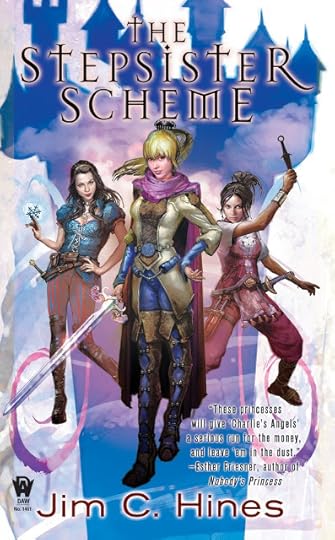
Right off the bat, I could see that this The Stepsister Scheme was different from other fairy tale adaptations I've read. It was told in the third person and placed a lot more emphasis on action and imagery than the characters' emotions, a common difference books written by men and women. By focusing on the darker Brothers Grimm versions of the stories instead of the more cheerful Perrault or Disney versions, Jim C. Hines was able to give each princess a believably tragic backstory that led up to their new tough-as-nails warrior personas. Each of the three protagonists had her own superpower. Danielle (Cinderella) had an enchanted glass sword that was left for her by her late mother, Talia (Sleeping Beauty) was a master at using a type of whip made from the spindle that she pricked her finger on, and Snow White had a collection of magic mirrors that she wore on a choker around her neck that could perform location and communication spells as well as attacks against certain types of dark creatures. It seemed as though they were more than equipped to rescue a single prince. That is, however, until they realized how powerful the magic that Danielle's stepsisters had tapped into was.
The Stepsister Scheme is incredibly fast-paced to the point where it can take some effort to keep track of all the magic and action that whizzes through each chapter. Parts of it reminded me of Lewis Carroll's Alice in Wonderland, namely when the girls needed to shrink themselves in order to become travel-sized on their quest to find Danielle's husband. Though the descriptions never got too graphic, it was pretty violent for what it was. Of the three princesses, Danielle was the least experienced in fighting and had to learn to toughen up under Talia's iron fist. There were also some subtle sexual references that would make me hesitant to recommend this book to underage readers. Tonally, it was more akin to Snow White and the Huntsman and Winter's War than something like Ella Enchanted . It's not my usual reading fare, but it was a welcome change of pace from all the linear retellings and reimaginings that focus solely on true love saving the day.
There are a lot of comparisons in the descriptions of The Stepsister Scheme to Charlie's Angels, but the book is so focused on girl-power that even the "Charlie" character is a woman. Queen Beatrice, Danielle's new mother-in-law, reveals early on that she has a hidden room beneath her castle where she recruits princesses from other kingdoms to go on quests. When Beatrice's son, Prince Armand, gets kidnapped, she allows Danielle to join the rescue party because she knows it's too personal for her to agree to stay behind. It turns out to be even more personal when Danielle realizes that she is carrying Armand's child. It becomes questionable at that point whether a pregnant woman should go on such a dangerous quest, but we soon learn that the baby is a key player in the schemes of Danielle's stepsisters, Charlotte and Stacia. Danielle must depend on the experience and skill of Talia and Snow if she ever wishes to get her husband back in time for the birth of their son.
The "Warrior Princess" archetype is not new to storytelling, but it isn't often that it gets combined with older storybook characters like Snow White, Cinderella, and Sleeping Beauty, who are usually seen as the exact opposite. What I liked about The Stepsister Scheme is that it didn't attempt to reimagine these stories like so many movies do and claim that everything you think you know is wrong, even though there were still some discrepancies about how the princesses' stories were told to the public and what they actually experienced. Instead, it picks up right after "happily ever after" and gives them a chance to turn the tide on their victimized pasts and take an active role in their futures. It is not an emotional story about finding love but instead an empowering action-driven adventure about claiming control. If that sounds like something you would be interested in, you will be happy to know that it is the first in a four-book series that features various other fairy tales.

Right off the bat, I could see that this The Stepsister Scheme was different from other fairy tale adaptations I've read. It was told in the third person and placed a lot more emphasis on action and imagery than the characters' emotions, a common difference books written by men and women. By focusing on the darker Brothers Grimm versions of the stories instead of the more cheerful Perrault or Disney versions, Jim C. Hines was able to give each princess a believably tragic backstory that led up to their new tough-as-nails warrior personas. Each of the three protagonists had her own superpower. Danielle (Cinderella) had an enchanted glass sword that was left for her by her late mother, Talia (Sleeping Beauty) was a master at using a type of whip made from the spindle that she pricked her finger on, and Snow White had a collection of magic mirrors that she wore on a choker around her neck that could perform location and communication spells as well as attacks against certain types of dark creatures. It seemed as though they were more than equipped to rescue a single prince. That is, however, until they realized how powerful the magic that Danielle's stepsisters had tapped into was.
The Stepsister Scheme is incredibly fast-paced to the point where it can take some effort to keep track of all the magic and action that whizzes through each chapter. Parts of it reminded me of Lewis Carroll's Alice in Wonderland, namely when the girls needed to shrink themselves in order to become travel-sized on their quest to find Danielle's husband. Though the descriptions never got too graphic, it was pretty violent for what it was. Of the three princesses, Danielle was the least experienced in fighting and had to learn to toughen up under Talia's iron fist. There were also some subtle sexual references that would make me hesitant to recommend this book to underage readers. Tonally, it was more akin to Snow White and the Huntsman and Winter's War than something like Ella Enchanted . It's not my usual reading fare, but it was a welcome change of pace from all the linear retellings and reimaginings that focus solely on true love saving the day.
There are a lot of comparisons in the descriptions of The Stepsister Scheme to Charlie's Angels, but the book is so focused on girl-power that even the "Charlie" character is a woman. Queen Beatrice, Danielle's new mother-in-law, reveals early on that she has a hidden room beneath her castle where she recruits princesses from other kingdoms to go on quests. When Beatrice's son, Prince Armand, gets kidnapped, she allows Danielle to join the rescue party because she knows it's too personal for her to agree to stay behind. It turns out to be even more personal when Danielle realizes that she is carrying Armand's child. It becomes questionable at that point whether a pregnant woman should go on such a dangerous quest, but we soon learn that the baby is a key player in the schemes of Danielle's stepsisters, Charlotte and Stacia. Danielle must depend on the experience and skill of Talia and Snow if she ever wishes to get her husband back in time for the birth of their son.
The "Warrior Princess" archetype is not new to storytelling, but it isn't often that it gets combined with older storybook characters like Snow White, Cinderella, and Sleeping Beauty, who are usually seen as the exact opposite. What I liked about The Stepsister Scheme is that it didn't attempt to reimagine these stories like so many movies do and claim that everything you think you know is wrong, even though there were still some discrepancies about how the princesses' stories were told to the public and what they actually experienced. Instead, it picks up right after "happily ever after" and gives them a chance to turn the tide on their victimized pasts and take an active role in their futures. It is not an emotional story about finding love but instead an empowering action-driven adventure about claiming control. If that sounds like something you would be interested in, you will be happy to know that it is the first in a four-book series that features various other fairy tales.
Published on January 18, 2020 16:40
January 12, 2020
Transformations
Odette turned into a swan. Ariel turned into a human. Tiana turned into a frog. Thumbelina turned into a faery. Transformation is such a huge theme among fairy tales that it is practically embedded into their DNA. If you think beautiful transformation sequences are just a visual motif, you would only be half right. This theme is so common among fables because it represents a storytelling technique that has existed ever since stories started being told. Every good story takes a character on a complete journey, whether physical or metaphorical, that changes them by the time they reach its end. Likewise, each princess or prince who has transformed into their final form by the end of the movie leans a powerful lesson from their experiences. We see that lesson visually through the magic of animation and visual effects. For me, transformation sequences are the ultimate high point of traditional animation.
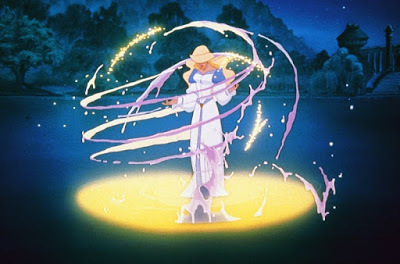
Every fairy tale princess begins her story as a sheltered ingenue who is thirsty for knowledge about the mysterious outside world. When she is set free to explore it, she learns about the existence of both darkness and light. She must struggle to remain pure and good despite how easy it would be to fight back against the forces that wish to do her harm. Each fairy tale transformation sequence is a metaphor for that journey. Ideally, by the time a princess has completed her transformative journey, she is a new person who is now ready to be queen. Sequels to princess movies rarely work because the princesses have become so different from who they were at the beginning of their story. Someone who loved and related to an ingenue might have more trouble relating to a more experienced and calculating adult. That's why it's often better to press the "reset" button and tell a new story about the same classic archetypes that people love and relate to.
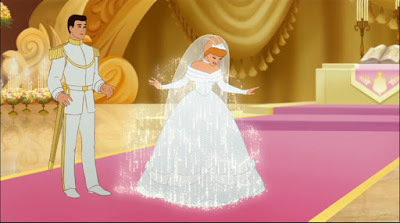
The most literal genre for transformation sequences is the Magical Girl genre. Though it is mostly used in anime, this style of girls' cartoons has slowly gained popularity in western media as well. Magical Girl shows contain beautiful montages of aesthetically pleasing battle uniforms materializing on the body of an ingenue in an extravagant show of ribbons and glitter. Unlike fables of old where a princess or prince was cursed to turn into an animal, magical girls become stronger, smarter, and more resilient when they transform, similar to how Cinderella's transformation brought out her own inner princess. It takes several seasons of a Magical Girl show to see the protagonists' mental and emotional maturity catch up to their sparkling ensemble. That is the one transformation that cannot be rushed and keeps viewers coming back for more.
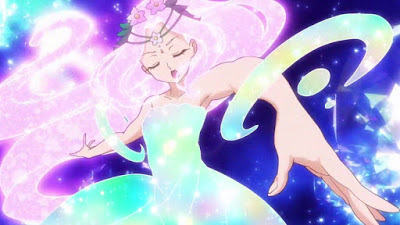
On a purely superficial level, I absolutely love watching transformation sequences in animation. They are like nothing I could ever see or experience in the real world. The glitter and elegance of a good transformation make me feel all warm and tingly inside and helps me imagine being the best person I can be without all the hard work and struggle that real life requires for such things. Some of us never achieve our ultimate goals for self-fulfillment, which is why seeing it happen in the blink of an eye is so satisfying. The artistry of creating something from nothing and bringing together the perfect combination of drawings, visual effects, and music is quite possibly the most stunning thing that a person's eyes can be fortunate enough to perceive.
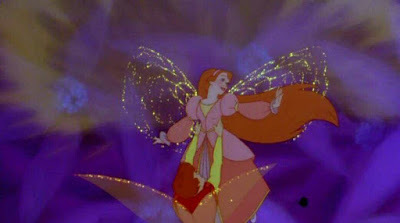
Transformations will always be one of the most beloved aspects of fairy tale princess stories. They are a beautiful visual representation of a person embracing their best self and sharing it with the rest of the world. They are also the pinnacle of animation, whimsy, and fantasy storytelling. Good stories always contain a transformative arc for the protagonist whether it is shown visually or not. Seeing it happen in such an extravagant way is the perfect cherry on top of a beautiful fairy tale. What's your favorite transformation sequence? Let me know below!

Every fairy tale princess begins her story as a sheltered ingenue who is thirsty for knowledge about the mysterious outside world. When she is set free to explore it, she learns about the existence of both darkness and light. She must struggle to remain pure and good despite how easy it would be to fight back against the forces that wish to do her harm. Each fairy tale transformation sequence is a metaphor for that journey. Ideally, by the time a princess has completed her transformative journey, she is a new person who is now ready to be queen. Sequels to princess movies rarely work because the princesses have become so different from who they were at the beginning of their story. Someone who loved and related to an ingenue might have more trouble relating to a more experienced and calculating adult. That's why it's often better to press the "reset" button and tell a new story about the same classic archetypes that people love and relate to.

The most literal genre for transformation sequences is the Magical Girl genre. Though it is mostly used in anime, this style of girls' cartoons has slowly gained popularity in western media as well. Magical Girl shows contain beautiful montages of aesthetically pleasing battle uniforms materializing on the body of an ingenue in an extravagant show of ribbons and glitter. Unlike fables of old where a princess or prince was cursed to turn into an animal, magical girls become stronger, smarter, and more resilient when they transform, similar to how Cinderella's transformation brought out her own inner princess. It takes several seasons of a Magical Girl show to see the protagonists' mental and emotional maturity catch up to their sparkling ensemble. That is the one transformation that cannot be rushed and keeps viewers coming back for more.

On a purely superficial level, I absolutely love watching transformation sequences in animation. They are like nothing I could ever see or experience in the real world. The glitter and elegance of a good transformation make me feel all warm and tingly inside and helps me imagine being the best person I can be without all the hard work and struggle that real life requires for such things. Some of us never achieve our ultimate goals for self-fulfillment, which is why seeing it happen in the blink of an eye is so satisfying. The artistry of creating something from nothing and bringing together the perfect combination of drawings, visual effects, and music is quite possibly the most stunning thing that a person's eyes can be fortunate enough to perceive.

Transformations will always be one of the most beloved aspects of fairy tale princess stories. They are a beautiful visual representation of a person embracing their best self and sharing it with the rest of the world. They are also the pinnacle of animation, whimsy, and fantasy storytelling. Good stories always contain a transformative arc for the protagonist whether it is shown visually or not. Seeing it happen in such an extravagant way is the perfect cherry on top of a beautiful fairy tale. What's your favorite transformation sequence? Let me know below!
Published on January 12, 2020 12:09
January 5, 2020
What's Coming in 2020
Last year was quite possibly the biggest year for princess media ever. I don't think anything from 2020 will compare to the sheer number of princess anniversary events, TV shows, books, and movies that 2019 bestowed upon us, but that doesn't mean we won't have anything to look forward to in the coming year. Two of our favorite Disney Princess cartoons will be ending soon, leaving us with a tiara-shaped hole in our hearts. Fortunately, the advent of Disney+ allows for even more original content from the studio than feature films or Disney Channel specials, promising some low-key princess entertainment while the cinemas get overrun with live-action remakes. One such upcoming Disney+ original princess movie is Secret Society of Second-Born Royals.

Secret Society of Second-Born Royals stars the immensely talented
Another upcoming Disney+ project is Frills , a "Cinderella" inspired movie in which the iconic Fairy Godmother character travels to our world to help a modern-day single mother. Very little information is available about Frills right now except that it will begin shooting this year. Whether or not it will hit Disney's new streaming service before 2021 is still unknown. The plot of Frills sounds suspiciously similar to a sitcom that ABC was supposed to release back in 2017 called The Real Fairy Godmother. The show was going to star
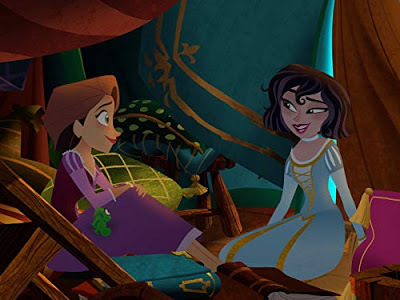
All good thing must come to an end, and that will sadly be the case for Tangled: The Series and Elena of Avalor this year. Release dates have already been announced for the last few episodes of Tangled, which will hopefully resolve Cassandra's dangerous rivalry with Rapunzel. The last batch of episodes will air every Sunday starting next week on January 12th and leading up to the 90-minute finale movie, Plus Est en Vous (which translates from French to "More Is in You"), on March 1st. This show has done such an amazing job of building up the drama, romance, and intrigue among its fairy tale characters over the years and has me very excited to find out what it will lead up to. Elena of Avalor has not announced an ending date yet, but it will likely be sometime this year with her coronation special. The next new episode of the show will air this Friday, January 10th with "The Birthday Cruise." As an added bonus, Craig Gerber announced on Twitter that this episode will include guest appearances from several other princesses that Elena has met throughout the show, including Chloe, Valentina, and Rebeca, Disney's first Jewish princess. After Tangled and Elena air their final episodes, it is unlikely that we will see another new Disney Princess series for a while since Star vs. The Forces of Evil ended last year, and Sofia the First ended the year before that.
Some other princess happenings in 2020 include the live-action remake of Mulan and the upcoming Kingdom Hearts 3 Re Mind DLC featuring Kairi as a playable character, which comes out later this month. It looks like yet another year of Disney championing the majority princess media that we will consume. This year also marks the 70th anniversary of Disney's Cinderella, which they will celebrate with several new Limited Edition dolls and possibly other events. I hope everyone has a happy and healthy 2020. Have you heard any upcoming princess news that I've missed? What are you looking forward to the most this year? Let me know in the comments below!

Secret Society of Second-Born Royals stars the immensely talented
Another upcoming Disney+ project is Frills , a "Cinderella" inspired movie in which the iconic Fairy Godmother character travels to our world to help a modern-day single mother. Very little information is available about Frills right now except that it will begin shooting this year. Whether or not it will hit Disney's new streaming service before 2021 is still unknown. The plot of Frills sounds suspiciously similar to a sitcom that ABC was supposed to release back in 2017 called The Real Fairy Godmother. The show was going to star

All good thing must come to an end, and that will sadly be the case for Tangled: The Series and Elena of Avalor this year. Release dates have already been announced for the last few episodes of Tangled, which will hopefully resolve Cassandra's dangerous rivalry with Rapunzel. The last batch of episodes will air every Sunday starting next week on January 12th and leading up to the 90-minute finale movie, Plus Est en Vous (which translates from French to "More Is in You"), on March 1st. This show has done such an amazing job of building up the drama, romance, and intrigue among its fairy tale characters over the years and has me very excited to find out what it will lead up to. Elena of Avalor has not announced an ending date yet, but it will likely be sometime this year with her coronation special. The next new episode of the show will air this Friday, January 10th with "The Birthday Cruise." As an added bonus, Craig Gerber announced on Twitter that this episode will include guest appearances from several other princesses that Elena has met throughout the show, including Chloe, Valentina, and Rebeca, Disney's first Jewish princess. After Tangled and Elena air their final episodes, it is unlikely that we will see another new Disney Princess series for a while since Star vs. The Forces of Evil ended last year, and Sofia the First ended the year before that.
Some other princess happenings in 2020 include the live-action remake of Mulan and the upcoming Kingdom Hearts 3 Re Mind DLC featuring Kairi as a playable character, which comes out later this month. It looks like yet another year of Disney championing the majority princess media that we will consume. This year also marks the 70th anniversary of Disney's Cinderella, which they will celebrate with several new Limited Edition dolls and possibly other events. I hope everyone has a happy and healthy 2020. Have you heard any upcoming princess news that I've missed? What are you looking forward to the most this year? Let me know in the comments below!
Published on January 05, 2020 12:43
January 1, 2020
Review: A Princess of Wind and Wave
Happy New Year, princesses! I concluded my 2019 with yet another of my favorite fairy tale, "The Little Mermaid."
A Princess of Wind and Wave
is the final book in Melanie Cellier's Beyond the Four Kingdoms series and her last book of 2019. Though it wasn't my favorite "Little Mermaid" adaptation of the year, it did focus on certain aspects of the fairy tale that other versions tend to overlook. A Captive of Wing and Feather, the previous book in the series, featured a protagonist who couldn't communicate with humans during daylight hours, which is something that would ordinarily apply more to "The Little Mermaid" than "Swan Lake." Perhaps it was for this reason that Isla does not lose her ability to speak in A Princess of Wind and Wave, making it one of the few "Little Mermaid" adaptations that does not require her to find an alternate method of communication on land such as writing or sign language. Instead, her limitations come in the form of giving up her iconic singing voice and a magical enchantment that prevents her from disclosing her true identity to humans.
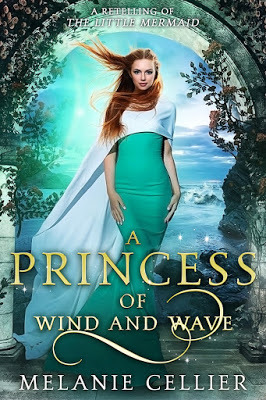
Like most "Little Mermaid" protagonists, Princess Isla is not your average mermaid princess. She doesn't want to stay safe and sound in her sunken kingdom and would rather spread her fins and practice fighting alongside the palace guards in the ocean beyond the barrier. On one such adventure, she rescues a golden-haired boy from drowning and hasn't been able to stop thinking about him ever since. When her father refuses to restore their kingdom to its rightful place on land two years later, she vows never to sing again until her kingdom is safe and ventures to the surface world with her young uncle where she encounters the boy she rescued once again. After she forms a bond with Prince Teddy and his sisters, Millie and Daisy, Isla realizes that many of the things her father told her about life on the surface were exaggerated or false. Now, she must team up with her new friends to uncover the source of the conspiracy and spread the truth to her people.
This book followed the traditional format of Melanie Cellier's Four Kingdoms and Beyond the Four Kingdoms series in which a fairy tale princess must uncover a royal scandal on her kingdom and defeat the traitor before it's too late. Isla is very much your average warrior princess who knows how to defend herself but is still capable of falling in love. Unfortunately, by making her character more independent than her Hans Christian Andersen counterpart, this book significantly lowered the stakes from the original fairy tale. Instead of permanently giving up the life she knows to become human and risking everything to win Teddy's love, Isla already has the ability to shapeshift. The kingdom Merrita is unique in that it exists within a giant bubble, and everyone within it takes on human form and their lives just like ordinary people. They shift into merfolk when they cross the edge of the barrier into the ocean, but that is a journey that is only considered necessary for palace guards when they go on scouting missions, which is Isla prefers to train alongside them than take on her regular princess duties.
Above all else, "The Little Mermaid" is a cautionary tale about the tribulations of love. This book places its own spin on that as well. Isla and Teddy thought that they fell in love with each other at first sight, but it isn't until they take the time to get to know each other that they understand what true love really is. They must then cast aside the ideals that exist in their imaginations in favor of the reality that they share together. As someone who is prone to crushes on fictional characters, this is something that I relate to all too well. Real love and fantasy love are different, but the passion behind both can feel just as powerful. I liked the overall message that love takes time to grow even though it seemed a little too convenient that Isla was able to find Teddy again so easily.
A Princess of Wind and Wave was an improvement over its predecessor, A Captive of Wing and Feather, but it lacked many of the sacrifices and stakes that made the original fairy tale so alluring. It was a good princess book with a strong protagonist that fits well into Melanie Cellier's godmother-centric world. However, if you are a fan of mermaid stories seeking a new fantastical underwater kingdom to explore, the sunken island of Merrita will be sure to disappoint as it is no different from any other mainland kingdom aside from the barrier around it that leads to the ocean. I would recommend this book to anyone who enjoys Melanie Cellier's other work or stories about strong empowered princesses.

Like most "Little Mermaid" protagonists, Princess Isla is not your average mermaid princess. She doesn't want to stay safe and sound in her sunken kingdom and would rather spread her fins and practice fighting alongside the palace guards in the ocean beyond the barrier. On one such adventure, she rescues a golden-haired boy from drowning and hasn't been able to stop thinking about him ever since. When her father refuses to restore their kingdom to its rightful place on land two years later, she vows never to sing again until her kingdom is safe and ventures to the surface world with her young uncle where she encounters the boy she rescued once again. After she forms a bond with Prince Teddy and his sisters, Millie and Daisy, Isla realizes that many of the things her father told her about life on the surface were exaggerated or false. Now, she must team up with her new friends to uncover the source of the conspiracy and spread the truth to her people.
This book followed the traditional format of Melanie Cellier's Four Kingdoms and Beyond the Four Kingdoms series in which a fairy tale princess must uncover a royal scandal on her kingdom and defeat the traitor before it's too late. Isla is very much your average warrior princess who knows how to defend herself but is still capable of falling in love. Unfortunately, by making her character more independent than her Hans Christian Andersen counterpart, this book significantly lowered the stakes from the original fairy tale. Instead of permanently giving up the life she knows to become human and risking everything to win Teddy's love, Isla already has the ability to shapeshift. The kingdom Merrita is unique in that it exists within a giant bubble, and everyone within it takes on human form and their lives just like ordinary people. They shift into merfolk when they cross the edge of the barrier into the ocean, but that is a journey that is only considered necessary for palace guards when they go on scouting missions, which is Isla prefers to train alongside them than take on her regular princess duties.
Above all else, "The Little Mermaid" is a cautionary tale about the tribulations of love. This book places its own spin on that as well. Isla and Teddy thought that they fell in love with each other at first sight, but it isn't until they take the time to get to know each other that they understand what true love really is. They must then cast aside the ideals that exist in their imaginations in favor of the reality that they share together. As someone who is prone to crushes on fictional characters, this is something that I relate to all too well. Real love and fantasy love are different, but the passion behind both can feel just as powerful. I liked the overall message that love takes time to grow even though it seemed a little too convenient that Isla was able to find Teddy again so easily.
A Princess of Wind and Wave was an improvement over its predecessor, A Captive of Wing and Feather, but it lacked many of the sacrifices and stakes that made the original fairy tale so alluring. It was a good princess book with a strong protagonist that fits well into Melanie Cellier's godmother-centric world. However, if you are a fan of mermaid stories seeking a new fantastical underwater kingdom to explore, the sunken island of Merrita will be sure to disappoint as it is no different from any other mainland kingdom aside from the barrier around it that leads to the ocean. I would recommend this book to anyone who enjoys Melanie Cellier's other work or stories about strong empowered princesses.
Published on January 01, 2020 15:04
December 22, 2019
Review: Beauty of Rosemead
It's been a while since I read Beast of Rosemead by Lucy Tempest. By the time I got around to its sequel, Beauty of Rosemead, I remembered very little except that the first book was very similar to the Disney adaptation of "Beauty and the Beast." Thankfully, Beauty of Rosemead had more than enough exposition to refresh my memory. As the fifth book in the Fairy Tales of Folkshore series and conclusion of Bonibel's story, I found it pretty enjoyable for what it was. I liked that Lucy shortened this story to two books since the Thief of Cahraman trilogy, her gender-swapped retelling of "Aladdin," ran a little too long with three books to tell a single story filled with exposition. She continues to shrink her garrulity with
Princess of Midnight
, the next book in the series, which is going to be a single standalone book. Beauty of Rosemead contained some of the same unnecessary exposition as the Thief of Cahraman and put too much focus on the eastern storytelling trope that children must take on responsibility for their parents' past mistakes when they come of age, but I liked it better than the Cahraman books overall.
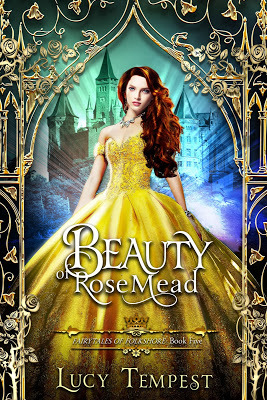
Beauty of Rosemead picks up right where Beast of Rosemead left off with Leander pushing Bonnie into a portal that would take her back to her home village for her own protection. Of course, Bonnie wasn't the type to sit around and wait while her loved ones were in trouble, so she chased right after Leander alongside her father and her friend Ella (who the next book will be about). The biggest overarching theme of Beauty of Rosemead is that sheltering someone under the guise of wanting to protect them will only result in resentment later on. Everyone in Bonnie's life treats her like a damsel in distress when in reality, she is the only one who can decide what sort of princess she wants to be. When she learns the truth about her past, it has a negative impact on every aspect of her life. Not only was she angry with her parents for hiding it from her, but Leander also assumed that she was intentionally hiding her true self from him as well, creating another obstacle in proving her love for him to turn him and his servants back into humans.
It was a little hard for me to keep track of all the characters in this book. Even though Bonnie and Leander as the main couple, there were also Leander's servants from the previous book, Ada and the other characters from the Thief of Cahraman trilogy, and all the fairy people Bonnie meets when she crosses over into the magical land of Faerie. There were a lot of details about Bonnie's family history that I found I simply wasn't that interested. I cared more about her current relationship with Leander than learning all the mistakes her parents made prior to her birth. Even though Lucy Tempest is an American writer, her books have themes that more common in Asian stories such as Dyesebel or Ashes of Love in which the main couple learns that the actions of their parents had a major impact on how they met and fell in love. This was just as pertinent in Beauty of Rosemead as it was in the Thief of Cahraman trilogy except that here it was more related to Leander's curse to become a beast than to how Bonnie fell in love with him. I would have liked to see this book go in a different direction. It would irk me if every adaptation in the Fairy Tales of Folkshore series is really about the protagonists' parents.
Unlike other "Beauty and the Beast" adaptations I've read in the past, this one was more about self-discovery than it was about romance. I didn't buy that Bonnie and Leander were this epic couple whose love was so powerful that it could overcome any curse, especially when the terms of Leander's curse were so vague that Bonnie wasn't even certain if she was the one who broke it at the end. I appreciated that most of the book was an original fantasy story and that Bonnie is a unique version of the "Beauty" character instead of another cookie-cutter bookworm. The ending was virtually identical to the Disney movie and felt as though Lucy was afraid to take the story her own direction for the big finale. I would have preferred for Bonnie to restore Leander's true form in a way that was specific to her character and more active than a mere a promise about their future. Though the book contains a detailed world with a map and a family tree of all the characters in the series, it still felt like something was missing when it came to the story.
Beauty of Rosemead is an adequate conclusion to Beast of Rosemead. It did an excellent job of building a rich world with a detailed history. I liked the themes of independence and self-discovery, but I wish that Bonnie and Leander were a stronger couple considering that the story theirs is inspired by what is considered one of the greatest love stories of all time. Though I had fun discovering Bonnie's past at first, the details became a little too heavy-handed after a while. The writing in this book was an improvement over the Thief of Caharaman trilogy. I hope that the future iterations of Fairy Tales of Folkshore will continue to improve. If you are a fan of the "Beauty and the Beast" fairy tale, I think it would be worth at least checking out Beast of Rosemead and continuing with Beauty of Rosemead if you enjoy it.

Beauty of Rosemead picks up right where Beast of Rosemead left off with Leander pushing Bonnie into a portal that would take her back to her home village for her own protection. Of course, Bonnie wasn't the type to sit around and wait while her loved ones were in trouble, so she chased right after Leander alongside her father and her friend Ella (who the next book will be about). The biggest overarching theme of Beauty of Rosemead is that sheltering someone under the guise of wanting to protect them will only result in resentment later on. Everyone in Bonnie's life treats her like a damsel in distress when in reality, she is the only one who can decide what sort of princess she wants to be. When she learns the truth about her past, it has a negative impact on every aspect of her life. Not only was she angry with her parents for hiding it from her, but Leander also assumed that she was intentionally hiding her true self from him as well, creating another obstacle in proving her love for him to turn him and his servants back into humans.
It was a little hard for me to keep track of all the characters in this book. Even though Bonnie and Leander as the main couple, there were also Leander's servants from the previous book, Ada and the other characters from the Thief of Cahraman trilogy, and all the fairy people Bonnie meets when she crosses over into the magical land of Faerie. There were a lot of details about Bonnie's family history that I found I simply wasn't that interested. I cared more about her current relationship with Leander than learning all the mistakes her parents made prior to her birth. Even though Lucy Tempest is an American writer, her books have themes that more common in Asian stories such as Dyesebel or Ashes of Love in which the main couple learns that the actions of their parents had a major impact on how they met and fell in love. This was just as pertinent in Beauty of Rosemead as it was in the Thief of Cahraman trilogy except that here it was more related to Leander's curse to become a beast than to how Bonnie fell in love with him. I would have liked to see this book go in a different direction. It would irk me if every adaptation in the Fairy Tales of Folkshore series is really about the protagonists' parents.
Unlike other "Beauty and the Beast" adaptations I've read in the past, this one was more about self-discovery than it was about romance. I didn't buy that Bonnie and Leander were this epic couple whose love was so powerful that it could overcome any curse, especially when the terms of Leander's curse were so vague that Bonnie wasn't even certain if she was the one who broke it at the end. I appreciated that most of the book was an original fantasy story and that Bonnie is a unique version of the "Beauty" character instead of another cookie-cutter bookworm. The ending was virtually identical to the Disney movie and felt as though Lucy was afraid to take the story her own direction for the big finale. I would have preferred for Bonnie to restore Leander's true form in a way that was specific to her character and more active than a mere a promise about their future. Though the book contains a detailed world with a map and a family tree of all the characters in the series, it still felt like something was missing when it came to the story.
Beauty of Rosemead is an adequate conclusion to Beast of Rosemead. It did an excellent job of building a rich world with a detailed history. I liked the themes of independence and self-discovery, but I wish that Bonnie and Leander were a stronger couple considering that the story theirs is inspired by what is considered one of the greatest love stories of all time. Though I had fun discovering Bonnie's past at first, the details became a little too heavy-handed after a while. The writing in this book was an improvement over the Thief of Caharaman trilogy. I hope that the future iterations of Fairy Tales of Folkshore will continue to improve. If you are a fan of the "Beauty and the Beast" fairy tale, I think it would be worth at least checking out Beast of Rosemead and continuing with Beauty of Rosemead if you enjoy it.
Published on December 22, 2019 15:39
December 16, 2019
PattyCake Productions Released a Holiday Princess Special!
It's a good year for princess holiday specials. Shortly after Elena of Avalor released a Hanukkah episode, PattyCake Productions premiered their latest Princess Academy short. I've always loved the incredible talent and attention to detail that goes into each one of PattyCake Productions' crowdsourced videos, and this was one of the best ones yet. Not only does it contain two completely original princess songs, but it also had a short storytelling session with gorgeous Disney quality illustrations. I also liked that they kept the story mostly secular since princess fans come from all backgrounds. Even though there was a Christmas tree and a mention of Christmas day in one of the songs, the princesses came together to celebrate an original holiday called the Winter Wishing Solstice and described some traditions that sounded very plausible for a fairytale-inspired religion. The short also featured an enormous cast with many characters that you don't see very often in Disney Princess lineups such as Giselle, Moana, Alice, and Charlotte LaBeouf.
The "Snowed In" webisode of Princess Academy premiered on PattyCake Productions' official YouTube channel on Friday, December 13th. It tells the story of a blizzard created by the Evil Queen in an attempt to ruin the princesses' Winter Wishing Solstice by preventing Merlin from joining their celebration to create the traditional magic wishing tree for their special day. The princesses explain their annual festivities to Giselle and Moana, who are unfamiliar with the holiday, which is a terrific metaphor for blending different cultures together. Anna and Elsa decide to brave the storm and rescue Merlin while the others wait by the tree as Cinderella regales them with a story about a little girl who thought that the only way to celebrate the holidays was by attending a yearly festival but then learned that it was really about being with her family. The story was illustrated with artwork reminiscent of the "Tough Love" episode of PattyCake Productions' Villains Lair series and looked like it came right out of a Disney movie.
I loved the production values of this short. Each princess looked and sounded exactly how she did in her movie right down to the way they clasp their hands over their heart and outstretch their arms when they get excited. Giselle's overdramatic gasp during the climax of Cinderella's story was hilarious, as well as Merida interrupting the story with her loud chewing as she crunched into a carrot. It was amazing how every princess behaved perfectly in character from Megara and Merida's snark to Anna insisting on going with Elsa save Merlin. It makes sense that Moana wouldn't be familiar with winter traditions as a pacific islander, so it was only appropriate that she sang the final line in the short to show how she now understood what the holidays mean to the other princesses.
Another thing I love about "Snowed In" is how inspired the Winter Wishing Solstice is as a secular princess holiday to an even greater extent than Wassalia from Sofia the First, which was more of a mash-up of every popular holiday. The Winter Wishing Solstice is about magic, wishes, and togetherness. Each kingdom from around the world brings a piece of one of their native trees so Merlin can blend them together to create a magical wishing tree for everyone to make their holiday wish upon. The wishes fly into the sky like Rapunzel's lanterns and become stars for everyone around the world to make wishes of their own just like Tiana. The concept inspires kindness and joy without being too preachy.
"Snowed In" might be my new favorite holiday special. If you haven't seen it already, you should definitely check it out. It's everything you could ever wish for from a princess special, and it's the perfect way to spark the joy of the holiday season. The songs, costumes, artwork, and acting were all lovely. You can really feel the passion that went into this project. I've always been a huge fan of PattyCake Productions, and I can't wait to see what they do next. Happy holidays, princesses!
The "Snowed In" webisode of Princess Academy premiered on PattyCake Productions' official YouTube channel on Friday, December 13th. It tells the story of a blizzard created by the Evil Queen in an attempt to ruin the princesses' Winter Wishing Solstice by preventing Merlin from joining their celebration to create the traditional magic wishing tree for their special day. The princesses explain their annual festivities to Giselle and Moana, who are unfamiliar with the holiday, which is a terrific metaphor for blending different cultures together. Anna and Elsa decide to brave the storm and rescue Merlin while the others wait by the tree as Cinderella regales them with a story about a little girl who thought that the only way to celebrate the holidays was by attending a yearly festival but then learned that it was really about being with her family. The story was illustrated with artwork reminiscent of the "Tough Love" episode of PattyCake Productions' Villains Lair series and looked like it came right out of a Disney movie.
I loved the production values of this short. Each princess looked and sounded exactly how she did in her movie right down to the way they clasp their hands over their heart and outstretch their arms when they get excited. Giselle's overdramatic gasp during the climax of Cinderella's story was hilarious, as well as Merida interrupting the story with her loud chewing as she crunched into a carrot. It was amazing how every princess behaved perfectly in character from Megara and Merida's snark to Anna insisting on going with Elsa save Merlin. It makes sense that Moana wouldn't be familiar with winter traditions as a pacific islander, so it was only appropriate that she sang the final line in the short to show how she now understood what the holidays mean to the other princesses.
Another thing I love about "Snowed In" is how inspired the Winter Wishing Solstice is as a secular princess holiday to an even greater extent than Wassalia from Sofia the First, which was more of a mash-up of every popular holiday. The Winter Wishing Solstice is about magic, wishes, and togetherness. Each kingdom from around the world brings a piece of one of their native trees so Merlin can blend them together to create a magical wishing tree for everyone to make their holiday wish upon. The wishes fly into the sky like Rapunzel's lanterns and become stars for everyone around the world to make wishes of their own just like Tiana. The concept inspires kindness and joy without being too preachy.
"Snowed In" might be my new favorite holiday special. If you haven't seen it already, you should definitely check it out. It's everything you could ever wish for from a princess special, and it's the perfect way to spark the joy of the holiday season. The songs, costumes, artwork, and acting were all lovely. You can really feel the passion that went into this project. I've always been a huge fan of PattyCake Productions, and I can't wait to see what they do next. Happy holidays, princesses!
Published on December 16, 2019 18:50
December 15, 2019
Kingdom Hearts Finally Shows Kairi Some Love!
Kingdom Hearts 3, which came out at the beginning of the year, was an enjoyable enough sequel if you could overlook some rushed storylines and underdeveloped characters. The character that got screwed over the most was Kairi, the series' only Princess of Heart that wasn't from a Disney movie. Kairi's development within the Kingdom Hearts series is important because she doesn't have a movie or spin-off to tell her story while Sora, Riku, and Roxas are all playable in various other games. We know that she grew up in Radiant Garden where her grandmother told her stories about the ancient Keyblade War and that she eventually found herself stranded on the Destiny Islands where she met Sora and Riku, but that is where her story ends. Kairi made multiple claims about wanting to help Sora after she got her own keyblade at the end of Kingdom Hearts 2, but we barely ever saw her use it. Even when she did during one of the final battles in Kingdom Hearts 3, she was highly unskilled with no special princess-inspired abilities. Never fear, Kairi fans, because as of next month, all of that is about to change.
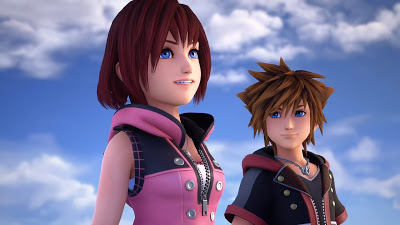
Kingdom Hearts recently released a new trailer for Kingdom Hearts 3: Re Mind that contained some earth-shattering revelations. Not only are the Final Fantasy characters who were notably absent from Kingdom Hearts 3 back, but Kairi has been officially revealed as a playable character in this bonus downloadable add-on. In the trailer, we see Kairi performing a beautiful attack is finally worthy of the training she did behind the scenes while Sora went on his adventures. The fast-paced sequence reveals her special movie as she flings her flowery keyblade at the enemy, warps to his location to recover it, and then leaps into to the air in a burst of prismatic light before zooming right in front of the camera in a move that is every bit as impressive as one of Sora's. The way she leaps through the air in a feat of acrobatics and grace is everything we could possibly hope for in a video game princess.
The beginning of the trailer features Sora and Kairi visiting what is essentially the Kingdom Hearts version of Heaven, which makes sense after Kingdom Hearts 3 left off with Kairi getting defeated by Xehanort and Sora deciding to go after her. The portion where Kairi becomes playable will likely take place after Sora finds her. As we saw from the ending of Kingdom Hearts 3, something happened to cause Kairi to return to the Destiny Islands without Sora. It makes perfect sense for her to want to go back and rescue after he sacrifices himself for her, which is probably what motivates her enough to use her new fighting skills. As an added bonus, it looks like the Re Mind DLC will allow us to play as Sora, Riku, and Kairi at various points throughout the game, which would mark it the first Kingdom Hearts spin-off in which the original Destiny Islands trio will be playable.
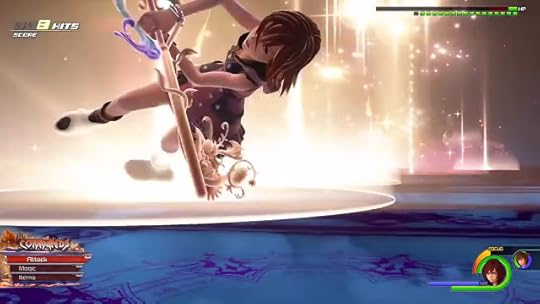
A lot of fans are saying that the footage in this DLC trailer came out in the initial Kingdom Hearts 3 release and not as bonus content. I enjoyed Kingdom Hearts 3 enough, but I agree that it could have been a lot better. While I would have liked these scenes to have taken plac in the actual game, I'm still happy to have an opportunity to see Kairi as a kick-ass warrior princess at all. Better late than never, right? There's also a gorgeous clip of the other Warriors of Light fighting for the fate of Kingdom Hearts simultaneously to Sora's battle in the Keyblace Graveyard. For better or worse, the Re Mind trailer has given me and many other Kingdom Hearts fans very high expectations for the future of the series. I hope I am able to play as Kairi for more than just one battle so I can learn about all her special abilities as a playable Princess of Heart.
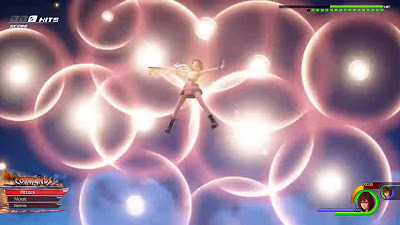
The Kingdom Hearts 3 Re Mind DLC is currently available in the PlayStation store for pre-order. Square claims that it will be released on January 23rd of next year even though the pre-order page says otherwise. It looks like this DLC is the game's answer to all of the complaints that people had about its third major installment. It's great to see that they were listening and are doing everything in their power to correct their mistakes. Kairi is an important character in Sora's life who has been there since there beginning and even saved him from turning into a Heartless in the first game. She deserves all the respect that we as fans have been patiently waiting for them to give her.

Kingdom Hearts recently released a new trailer for Kingdom Hearts 3: Re Mind that contained some earth-shattering revelations. Not only are the Final Fantasy characters who were notably absent from Kingdom Hearts 3 back, but Kairi has been officially revealed as a playable character in this bonus downloadable add-on. In the trailer, we see Kairi performing a beautiful attack is finally worthy of the training she did behind the scenes while Sora went on his adventures. The fast-paced sequence reveals her special movie as she flings her flowery keyblade at the enemy, warps to his location to recover it, and then leaps into to the air in a burst of prismatic light before zooming right in front of the camera in a move that is every bit as impressive as one of Sora's. The way she leaps through the air in a feat of acrobatics and grace is everything we could possibly hope for in a video game princess.
The beginning of the trailer features Sora and Kairi visiting what is essentially the Kingdom Hearts version of Heaven, which makes sense after Kingdom Hearts 3 left off with Kairi getting defeated by Xehanort and Sora deciding to go after her. The portion where Kairi becomes playable will likely take place after Sora finds her. As we saw from the ending of Kingdom Hearts 3, something happened to cause Kairi to return to the Destiny Islands without Sora. It makes perfect sense for her to want to go back and rescue after he sacrifices himself for her, which is probably what motivates her enough to use her new fighting skills. As an added bonus, it looks like the Re Mind DLC will allow us to play as Sora, Riku, and Kairi at various points throughout the game, which would mark it the first Kingdom Hearts spin-off in which the original Destiny Islands trio will be playable.

A lot of fans are saying that the footage in this DLC trailer came out in the initial Kingdom Hearts 3 release and not as bonus content. I enjoyed Kingdom Hearts 3 enough, but I agree that it could have been a lot better. While I would have liked these scenes to have taken plac in the actual game, I'm still happy to have an opportunity to see Kairi as a kick-ass warrior princess at all. Better late than never, right? There's also a gorgeous clip of the other Warriors of Light fighting for the fate of Kingdom Hearts simultaneously to Sora's battle in the Keyblace Graveyard. For better or worse, the Re Mind trailer has given me and many other Kingdom Hearts fans very high expectations for the future of the series. I hope I am able to play as Kairi for more than just one battle so I can learn about all her special abilities as a playable Princess of Heart.

The Kingdom Hearts 3 Re Mind DLC is currently available in the PlayStation store for pre-order. Square claims that it will be released on January 23rd of next year even though the pre-order page says otherwise. It looks like this DLC is the game's answer to all of the complaints that people had about its third major installment. It's great to see that they were listening and are doing everything in their power to correct their mistakes. Kairi is an important character in Sora's life who has been there since there beginning and even saved him from turning into a Heartless in the first game. She deserves all the respect that we as fans have been patiently waiting for them to give her.
Published on December 15, 2019 22:50



